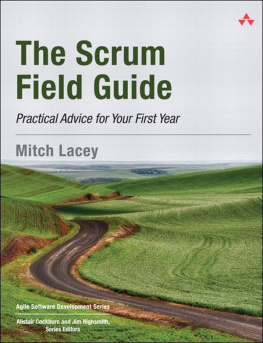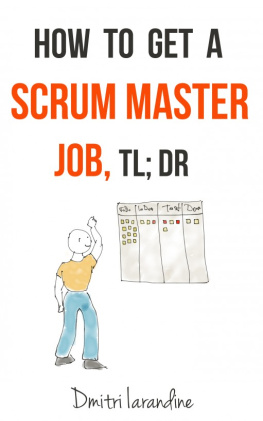The Scrum Field Guide
Practical Advice for Your First Year
Mitch Lacey

Upper Saddle River, NJ Boston Indianapolis San Francisco
New York Toronto Montreal London Munich Paris Madrid
Capetown Sydney Tokyo Singapore Mexico City
Many of the designations used by manufacturers and sellers to distinguish their products are claimed as trademarks. Where those designations appear in this book, and the publisher was aware of a trademark claim, the designations have been printed with initial capital letters or in all capitals.
The author and publisher have taken care in the preparation of this book, but make no expressed or implied warranty of any kind and assume no responsibility for errors or omissions. No liability is assumed for incidental or consequential damages in connection with or arising out of the use of the information or programs contained herein.
The publisher offers excellent discounts on this book when ordered in quantity for bulk purchases or special sales, which may include electronic versions and/or custom covers and content particular to your business, training goals, marketing focus, and branding interests. For more information, please contact:
U.S. Corporate and Government Sales
(800) 382-3419
For sales outside the United States please contact:
International Sales
Visit us on the Web: informit.com/aw
Library of Congress Cataloging-in-Publication Data
Lacey, Mitch.
The scrum field guide : practical advice for your first year / Mitch
Lacey.1st ed.
p. cm.
Includes index.
ISBN 0-321-55415-9 (pbk. : alk. paper)
1. Agile software development. 2. Scrum (Computer software development)
I. Title.
QA76.76.D47L326 2012
005.1dc23 2011040008
Copyright 2012 Mitchell G. Lacey
All rights reserved. Printed in the United States of America. This publication is protected by copyright, and permission must be obtained from the publisher prior to any prohibited reproduction, storage in a retrieval system, or transmission in any form or by any means, electronic, mechanical, photocopying, recording, or likewise. To obtain permission to use material from this work, please submit a written request to Pearson Education, Inc., Permissions Department, One Lake Street, Upper Saddle River, New Jersey 07458, or you may fax your request to (201) 236-3290.
ISBN-13: 978-0-321-55415-4
ISBN-10: 0-321-55415-9
Text printed in the United States on recycled paper at RR Donnelley in Crawfordsville, Indiana.
Second printing, October 2013
This book is dedicated to two teams; The first team is my family. My wife, Bernice, and my kids, Ashley, Carter, and Emmawithout their support and constantly asking are you done yet? this book would not be here. They kept me focused and supported me throughout.
The second team is the group of guys from the Falcon project while at Microsoft. John Boal, Donavan Hoepcke, Bart Hsu, Mike Puleio, Mon Leelaphisut, and Michael Corrigan (our boss), thank you for having the courage to leap with me. You guys made this book a reality.
Contents
Foreword by Jim Highsmith
Scrum is elegantly deceptive. It is one of the easiest frameworks to understand yet one of the hardest frameworks to implement well. So begins of this thought-provoking and valuable guide to Scrum. Ive seen too many organizations get caught up in the assumed simplicity of Scrumthey never seem to make it past Scrum 101 to a mature view of Scrum. They practice rule-based agility and dont appear to see the irony. They dont understand that change, particularly in larger organizations, will be difficultthe path bumpyno matter how devoted they are to implementationand that a few simple rules just arent enough. This guide helps you move beyond Scrum 101 to a mature, realistic implementation. It isnt about the basic Scrum framework (except for an appendix); its about all the harder, but practical, aspects of making the Scrum framework work for you and your team.
When it comes to agile transitions two hot buttons are often overlooked in attempts to get Scrum (or other frameworks) up and runningrelease planning and technical practices. Mitch is very clear from the beginning that technical practices are critical to effective Scrum implementations. As he points out, its impossible to achieve the goal of shippable software every sprint without implementing solid technical practices. His basic listtest-driven development, refactoring, continuous integration and frequent check-ins, pair programming, and integration and automated acceptance testingdefines a great starting place for technical practices.
I had to laugh at the story conversation in the (each chapter has a lead-in story that illustrates the issues to be addressed). But Stephen, were using Scrum. I cant tell you exactly when well be done. Stephen, of course, was the manager who needed project completion information for his management chain. One of the key mindsets required to be an effective agile leader is what I call And management, the ability to find common ground between two seemingly opposite forces. One of these common paradoxes in Scrum projects is that between predictability and adaptability. Traditionalists tend to come down on the side of predictability, while some agilists come down on the adaptability side. The secret, of course, is to balance the twofiguring out how to do appropriate levels of both. In his chapter on release planning, Mitch gives us some good guidelines on how to approach this paradox in a practical And management fashion.
In a recent conversation a colleague mentioned the two things he considered critical in a nascent Scrum implementationlearning and quick wins. Mitch addresses both of these in learn and adapt as the transition to Scrum continues. Getting quick wins is one of the points Mitch describes as part of John Kotters popular change management system.
Another plus of this book is the short chapters, each devoted to a topic that helps turn the basic Scrum framework into a workable framework by advocating key practices. These run the gamut from discussing Scrum values, to defining roles, to calculating velocity, to determining sprint lengths, to decomposing stories, to conducting customer reviews. There is also a fascinating chapter on defining what done meansa necessity for effective Scrum projects.
For anyone who is implementing Scrum, or any other agile method for that matter, Mitchs book will definitely help you make the transition from elegantly simple to effective, practical results. It may not make the hard stuff easy, but at least you will understand what the hard stuff is all about.
Jim Highsmith
Executive Consultant, ThoughtWorks
Foreword by Jeff Sutherland
Mitch and I have worked together for many years training developers in Scrum. Studying this book can help users overcome the biggest challenges that have occurred in the last ten years as agile practices (75 percent of which are Scrum) have become the primary mode of software development worldwide.
Ten years after the Agile Manifesto was published, some of the original signatories and a larger group of agile thought leaders met at Snowbird, Utah, this time to do a retrospective on ten years of agile software development. They celebrated the success of the agile approach to product development and reviewed the key impediments to building on that success. And they came to unanimous agreement on four key success factors for the next ten years.
1. Demand technical excellence.
2. Promote individual change and lead organizational change.
3. Organize knowledge and improve education.










